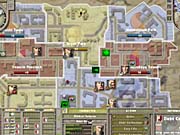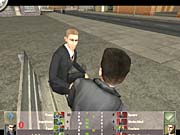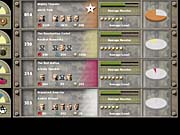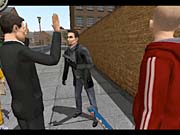Politics abhors a vacuum, and after the fall of the Soviet Union, there were plenty of strong men willing to step up and lead newly independent republics--like Novistrana. In this fictional state, the democratic process lasts but a single election. President Karasov shows his true colors within weeks, declaring himself president for life, instigating mass arrests, and outlawing all opposing political parties. Most wouldn't dare stand up against such a figure, but that's exactly the job you're charged with in Elixir's Republic: The Revolution. It's prime territory to move beyond the kosher politics of stately fundraisers and television issue ads and get your hands dirty with propaganda campaigns, slanderous attacks, and targeted violence. It's just too bad that overly linear missions and noninteractive 3D action get in the way of the deep political strategizing of Republic's later levels.

The core game is quite free-form and consists of winning grassroots support, gaining political capital, and undermining opposing factions, but there's no getting around having to do missions to advance the story and, eventually, decide the fate of Novistrana. A new game kicks off with a questionnaire to determine your character's base stats and political leanings and then drops you in the small provincial city of Ekaterine, where your budding faction has some clout in a single district. There isn't a dedicated tutorial section to explain basic concepts like how the district colors (red, blue, and yellow) match up with their political leanings (force, influence, and wealth) or how gaining control over these districts earns you the game's three corresponding resources. You'll have to read the manual for that. But, accompanied by some static in-game screens to explain the interface, the early missions do guide a new player through some of the steps necessary to grow from these very humble beginnings to become a dominant force in the city.
Republic doesn't adopt standard game conventions, so it can take some work to learn the game's interface and figure out what's involved in playing it. There are two main views: A 3D view of the large clockwork cities lets you zoom in on any of the buildings, cars, or inhabitants, while the 2D overhead view makes it easier to schedule and track actions throughout a city. Even though the 3D close-ups are clearly more visually appealing, the vast majority of the game is actually played in the overhead view, which provides essential information, such as the support levels each party enjoys in a given city district, the locations of operatives, and much more.
The overhead screen is also the only practical way to use "actions," the selection of abilities that each faction member possesses. Actions are the very core of the game. Many come with intriguing or forceful names like "honeytrap," "easy life," "intimidate," "riot," and "crime syndicate," but the majority feature bread-and-butter political activities like leafleting, organizing rallies, or instigating passive protests. In later parts of the game, you can have up to six agents simultaneously engaged in various activities all over a city, and to keep things manageable, executing actions is a pretty hands-off process. All actions are scheduled ahead of time, in the daily planner interface that pops up at the bottom of the screen, with each day divided into three time segments (morning, afternoon, and night). As long as you have the resources, you can queue up as many actions as you'd like, but the need to react to the changing political atmosphere can undercut long-range plans.
At normal speed, each eight-hour phase lasts about four real-time minutes, so there's plenty of time to drop into the close-up view and take a look around the city. It's easy enough to jump right to the locations of your agents--or even to members of opposing factions that you've identified--and watch them execute assigned actions. Most of the time there isn't much to do, and only exceptional events are animated in an entertaining way. Some actions do provide a slider at the bottom of the screen that lets you tweak, say, the sort of rhetoric used at a rally. But this option appears for such a brief time that it's easy to miss if there's anything else going on, and, in any case, the benefits aren't terribly apparent. Fortunately, if there's not much going on in a given phase, it's possible to speed the game time up considerably. Sometimes we still wished for an end-turn button.

The one and only critical activity to monitor in 3D is what Elixir calls the "conversation game," a minigame that plays out like a card-game duel. This duel determines the success or failure of many recruitment actions as well as a number of story-critical efforts that otherwise involve convincing someone to help the cause. The point of it all is to reach a certain threshold--which is determined by the relative abilities and levels of the political resolve, or loyalty, of dueling characters--and there's some basic strategy involved in figuring out how to divide up the points and play them most effectively. It's not hard to figure out the patterns the computer usually uses, but there's enough variety to keep things somewhat interesting. But it is too bad that the 3D characters speaking the game's made-up Russian-like language don't react at all to what's going on in the minigame.
For as much challenge as the free-form side of the game can offer, it can take more time to get through the linear missions than it does to hit upon a winning strategy and gain the support in most of a city. The story unfolds with a few scripted sequences that act out the president's rise to power and his despotic acts, and there's a series of newspaper clippings and memos to explain what's really going on. But the memos from your mentor and lieutenants are not just there for some context--mostly they throw up hoops to jump through. As major plot points, some missions sound pretty cool--there are jail breaks, raids on rivals, rigged elections, reluctant benefactors, and plenty more. In practice, however, they just involve using the ordinary range of actions for very narrowly defined goals. To add some extra challenge, a memo doesn't always quite say what the mission is about, but fortunately there's a summary screen to spell things out more clearly.
A number of missions will have you hunting and clicking around the 3D world for people or clues that are essential to advancing, but to succeed these missions, you'll have to have a solid grasp on how the multistep process of such investigation works. Gathering intelligence and spreading misinformation is one of the game's more interesting concepts, and cutting through the "fog of war" involves doing investigation actions that increase your general knowledge of a certain area (this level decays over time to keep investigating agents busy). With sufficient intelligence, you'll see exactly where opponent actions are taking place and, very importantly, also be able to click around for the "dig deeper" bubbles that pop up when there's something extra to investigate. Getting the dirt can take an extra turn, since you have to have an agent investigating that very district when you click on the building. The system isn't obvious at first, but it's absolutely necessary to advance through the game.

Ekaterine is just the jumping-off point on the way to the president's mansion, and the later two cities are considerably larger and more interesting. At each transition, there's the choice of which lieutenants to leave behind to watch over this power base and send resources along to your operations in the next city. In the second city, you'll meet more powerful individuals to recruit. That doesn't mean longtime agents have to be cast aside, since they will also gain levels over time and earn new abilities related to their character class.
The late-game abilities are mostly extensions on the basic actions that cost more to use, but fortunately many have a wider, even citywide, area of effect, which radically simplifies the process of gaining support--if you have the resources. It's also possible to "dig deeper" and find hidden characters that have particularly rare abilities, like "hit man." As you'd expect, this action puts a contract on an opposing agent--but it's surprisingly hard to use. The big hurdle is to know all the target's actions (perhaps seven or eight for a high-level target), which means he had to use them in districts you had under close surveillance.
This high threshold is an example of how little permanent violence the game actually has, for all the vandalism, assault, and blackmail a force-centric character might unleash. Sitting through the 3D sequences that illustrate such actions, there are plenty of instances where violence is played for comic effect, but more often the sequences feature blustering threats or menacing talk (and gibberish at that). Overall, it's dry stuff, particularly the serious political endeavors, like having a priest get up on a soapbox to slander an opponent or having a gang stand on street corners waiting for someone--anyone, please!--to walk by and take a leaflet. As rare as it is that you truly influence 3D events as they unfold, it's even rarer to see characters react usefully to the success or failure of an event.
The visuals can look quite good at any given moment. Buildings are rendered superrealistically and look equally sharp at a distance and zoomed in, where you might get close enough to see details like a variety of foods at different street vendors. The cities have a realistic scale, which makes the Soviet architecture of institutional buildings look all the more imposing. In contrast to all that detail, people have a caricatured look. But the way they move is what's really off-putting. At the beginning of a phase with an important conversation, the camera will lock on an odd pathfinding dance, with characters going out of their way on indirect paths before finally coming together for a friendly salute. Such events aren't hand-scripted--you pick the specific location--and it's obvious. Other story events display similarly awkward pacing, with drawn-out set-up shots of 20 seconds or more just showing cars rolling up and a few peripheral people getting out. It wouldn't be quite so tedious except for the fact that the camera is locked for the least entertaining and least interactive parts of these sequences.

For as large and complex as the city environments are, the game runs remarkably smooth--if you have a good enough system. At the normal game speed, the game was playable on a PC near the minimum specs--512MB of memory and an 800MHz CPU--but once you speed things up to end turns, the interface becomes unresponsive. But a PC with lots of memory and a fast CPU (over 2GHz) can keep the power on in Novistrana, with few performance hesitations. Still, we did encounter a minor technical issue that had us saving and restarting the game periodically--and, unfortunately, saving takes quite a long time. As for the audio, the fake Russian often sounded as if lines from different actors were edited together, undercutting whatever dramatic interest the dialogue might convey.
Republic is the result of lofty technical ambitions and sustained development delays. Unfortunately, the huge clockwork 3D world that took so long to construct ends up as the least involving part of the game. The core game, on the other hand, can be at times fascinating in its free-form simulation of grassroots politics and utterly frustrating with its single-mindedly linear missions. Even if the interface is a challenge to learn, the 2D presentation is as clear as could be, and gaining traction in the later cities suitably rewards those with a clear strategy in recruiting key people with complementary actions and then executing combinations of actions. Those looking for replay value may appreciate the four difficulty settings, the several branching paths in the mission structure, and the varying strategies for each of the three ideologies. But what would have been even better is an open-ended sandbox mode to focus on the political competition and havoc that gives Republic its best moments.